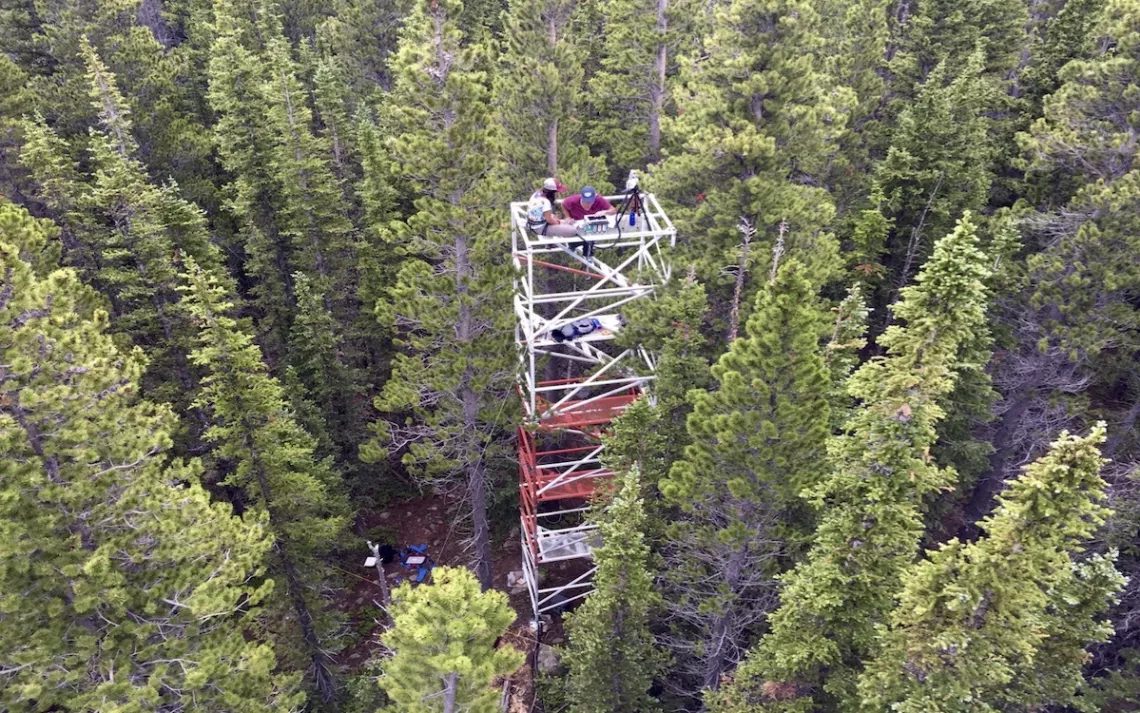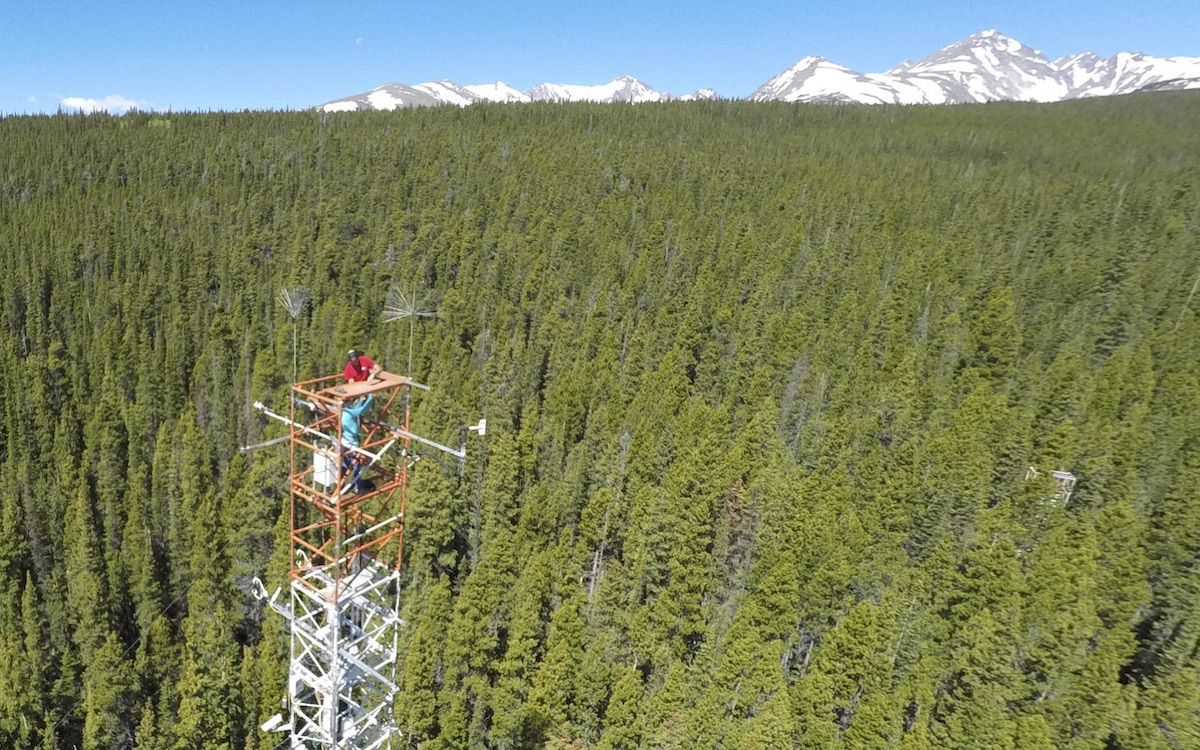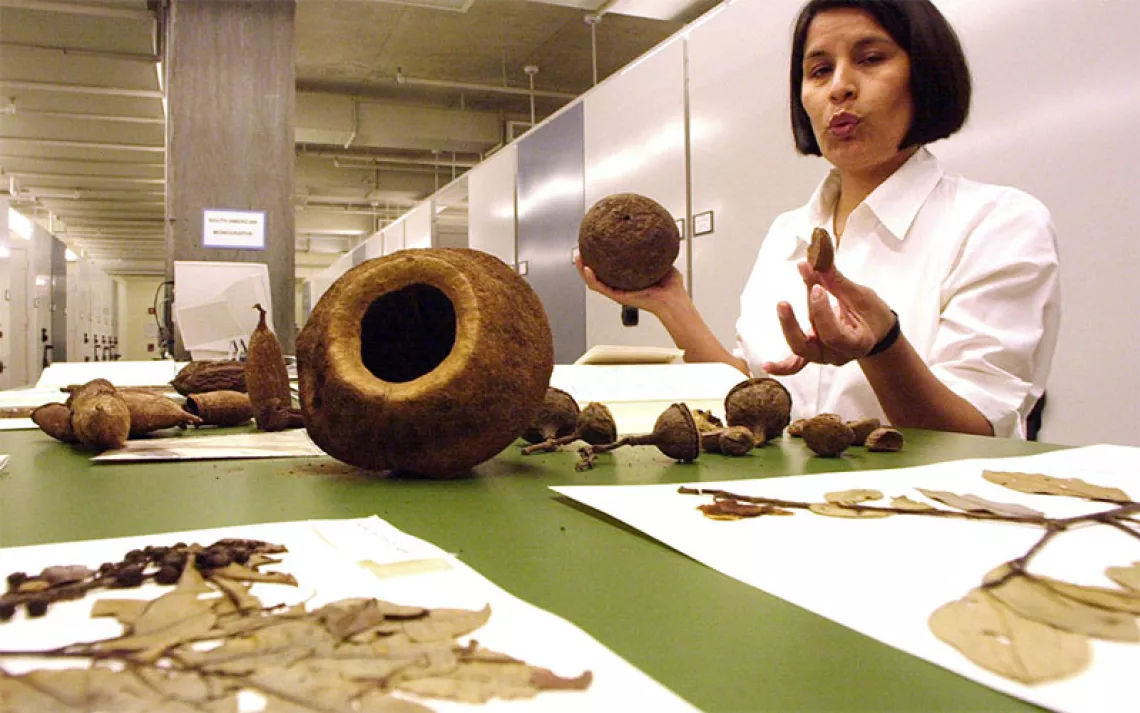Fluorescent Evergreen Glow Tells When Trees Are Taking Up Carbon
Researchers are learning how to interpret the faint light given off by the trees

Photos courtesy of Troy Magney
It’s pretty simple to tell when deciduous trees are photosynthesizing—their leaves are green. When that process is over for the year, the foliage shrivels up, turns brown, and falls off, an event so widespread it can be tracked by satellites in space. But tracking when evergreen trees crank up their chloroplasts and begin turning sunlight and CO2 into energy is much more difficult since, as their name implies, they stay green year-round (the trees actually stop photosynthesizing in the autumn but use a green pigment as a type of sunblock, keeping them green year-round). That has been a problem when it comes to climate modeling, which currently relies on estimates to determine how much CO2 evergreen forests pull out of the atmosphere. But a new study suggests there’s another way to keep tabs on photosynthesis in evergreen forests: watching their fluorescent glow from space.
Decades ago, researchers realized that chlorophyll gives off a tiny, difficult-to-detect fluorescent glow. When sunlight hits chlorophyll—the green pigment that produces energy in most plants—it bumps it into an excited energy state. When the chlorophyll returns to its normal state, it emits 2 to 4 percent of that energy as a photon, or light particle, in the red and far-red light wavelengths. The glow is called solar-induced fluorescence (SIF) and, though not visible to the naked eye, it can be picked up by spectrometers, sensitive instruments that detect wavelengths of light.
In 2011, researchers first used satellite data to measure plant fluorescence, but scientists are still figuring out what the glow actually means. “Because they’re always green, it’s harder to know when photosynthesis might ramp up and when it might ramp down in evergreens,” says Troy Magney of the California Institute of Technology and NASA’s Jet Propulsion Laboratory, first author of the new study in The Proceedings of the National Academy of Sciences. “Beyond that, the typical remote sensing techniques we use to look at evergreen species basically just measure the amount of reflected radiation in the near infrared and red spectrum, which really just tells us how much green stuff there is. But we really don’t know what that green stuff is doing. We have no idea when they start photosynthesis and how much carbon they take up.”
Magney and his colleagues decided to see if they could learn to pull more information out of the glow of the pines. To do so, they built a tower in the middle of the subalpine conifer forest at Niwot Ridge, an ecology research station outside Boulder, Colorado. They outfitted the tower with a spanning spectrometer, which kept track of the SIF coming off the surrounding forest, tracking both daily and seasonal cycles from June 2017 to June 2018. They also investigated some of the trees themselves to see if the fluorescence corresponded to real-world upticks and decreases in photosynthesis.
The SIF, it turns out, is a pretty good measure of photosynthesis, meaning tracking evergreen fluorescence is a viable way to measure the energy produced by photosynthesis, or gross primary production, of the forests.

Not only could the technique finally give researchers a good handle on the amount of carbon evergreens pull in, it could also be used to monitor forest health since photosynthesis is likely to drop in the early stages of drought, insect infestation, or the advent of tree diseases. Currently, researchers don’t usually know a forest is in trouble until large swathes are dead or dying.
The technique could also solve several mysteries about pine forests. Whereas pines in the boreal forest or alpine regions shut off photosynthesis for the winter, it’s believed that conifers in the southeastern United States keep producing at least some energy all year round. Monitoring the SIF of those forests could provide an answer to how much energy they produce in the winter months.
It could also help researchers untangle the life cycle of evergreen forests. It’s believed that younger forests are a net carbon sink—they pull more carbon out of the atmosphere than they produce. But at a certain point, Magney says, it’s believed that they become a carbon source—older forests stay green even as the trees within them begin the long, slow process of dying, which releases CO2.
“I would say the general consensus is confusion as to the fate of evergreen forests,” Magney says. “There’s been a debate for decades about whether the boreal forest is greening or browning. Both are happening, but we don’t know what’s driving it. Combining these new techniques with information on soil moisture, air temperature, humidity, and other factors we could find out.”
The study has already led to one surprise. Using the SIF data, the team found that when photosynthesis kicks in at springtime, it’s not a gradual process. The pines in Colorado ramped up from dormant to producing maximum energy in two weeks, much quicker than hypothesized.
The team is currently working on a supersize version of the experiment and over the last year installed six more towers in various forests, including Costa Rica, Saskatchewan, and Alaska, which they hope will teach them how to properly interpret the fluorescence data coming from space.
Currently, two NASA probes are capable of providing SIF data: the Orbiting Carbon Observatory-2, launched in 2014, and the Orbiting Carbon Observatory-3, a module attached to the space station, launched just last month. But the team hopes that future satellite missions will include even more sensitive spectrometers to provide fine-grained data. Currently, the sensors in orbit measure areas of about one by two kilometers. Magney says something with pixels representing 100 by 100 meters would be more useful.
He may soon get his wish. The European Space Agency is scheduled to launch the $172.4 million Fluorescence Explorer satellite in 2023, which will undertake a three-year mission to monitor the fluorescence given off by Earth’s vegetation. Thanks to this study, and others to come, we may know in much more detail what that faint glow really means.
 The Magazine of The Sierra Club
The Magazine of The Sierra Club



